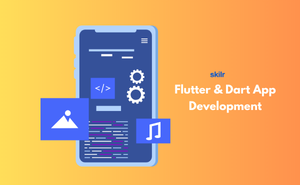👇 CELEBRATE CLOUD SECURITY DAY 👇
00
HOURS
00
MINUTES
00
SECONDS

The Flutter & Dart App Development certification focuses on equipping learners with the ability to build modern, cross-platform applications. Flutter, developed by Google, allows developers to create apps for mobile, desktop, and web using one shared codebase, while Dart serves as the programming language powering these apps with speed and reliability.
Through this program, participants gain the knowledge to develop apps that are visually appealing and responsive, all while saving time by avoiding repetitive coding for different platforms. This makes app creation easier, faster, and more accessible for professionals and businesses alike.
Who should take the Exam?
This exam is ideal for:
Domain 1 - Introduction to Flutter & Dart
Domain 2 - Dart Programming Fundamentals
Domain 3 - Flutter Basics
Domain 4 - Building User Interfaces
Domain 5 - Navigation and State Management
Domain 6 - Working with Data
Domain 7 - App Testing and Debugging
Domain 8 - Publishing and Deployment
Domain 9 - Future of Flutter & Dart
Industry-endorsed certificates to strengthen your career profile.
Start learning immediately with digital materials, no delays.
Practice until you’re fully confident, at no additional charge.
Study anytime, anywhere, on laptop, tablet, or smartphone.
Courses and practice exams developed by qualified professionals.
Support available round the clock whenever you need help.
Easy-to-follow content with practice exams and assessments.
Join a global community of professionals advancing their skills.
E-commerce, healthcare, fintech, social media, and startups.
Flutter is growing rapidly, with increasing adoption in businesses and strong support from Google.
Yes, Flutter developers are in high demand, especially for startups and small businesses.
No, Dart is beginner-friendly and similar to languages like Java or JavaScript.
Yes, Flutter supports web development alongside mobile and desktop.
Mobile app developer, cross-platform developer, UI/UX-focused developer, freelancer.
It uses its own rendering engine, allowing consistent UI across platforms.
Students, developers, entrepreneurs, and anyone interested in app development.
Yes, Flutter allows building apps for Android, iOS, and more using the same code.
Basic programming knowledge helps, but beginners can also learn step by step.